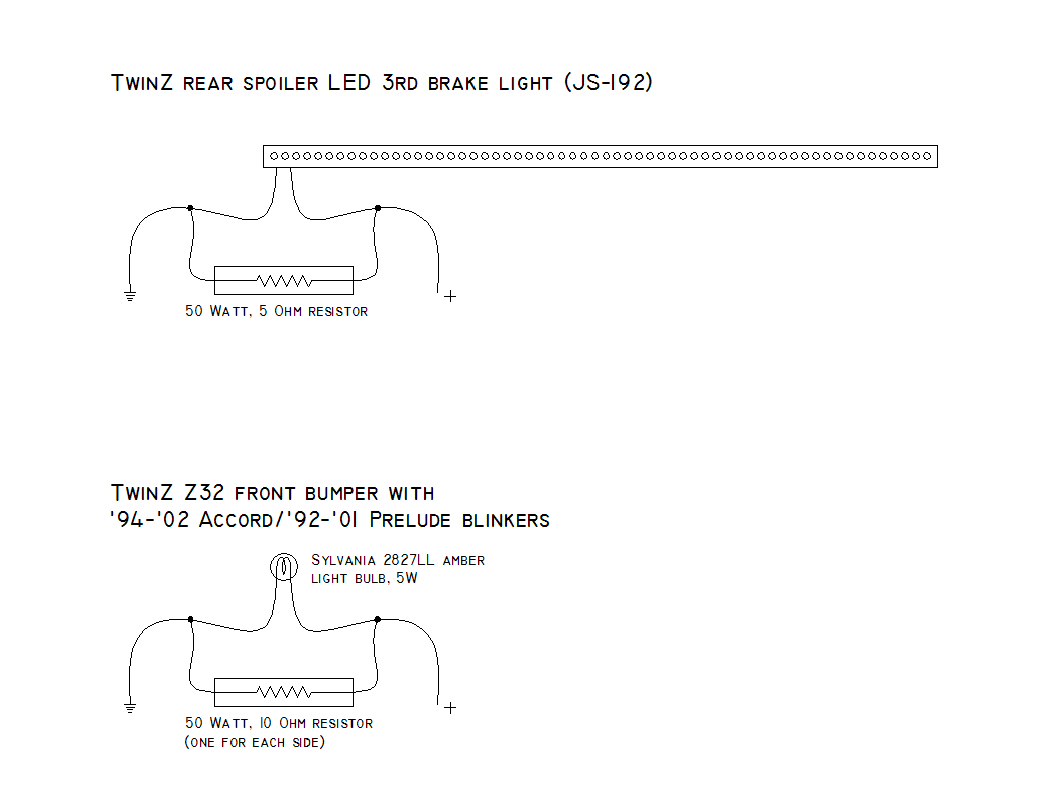| I recently installed both the TwinZ Type 1 rear spoiler with LED 3rd brake light and TwinZ front bumper which uses Honda Accord/Prelude marker lights for blinkers. The LED 3rd light causes the Z32's "brake light out" dash warning light to come on whenever stepping on the brakes and the Honda Accord/Prelude markers only use small, wedge type bulbs which cause the blinkers to blink extremely fast "hyper flashing" due to their lower power consumption. There's an easy fix for both... resistors. Not just any resistors out of your Pa's old Sony Walkman though; these need some thought put into them before choosing and installing. For those who don't care why or how to figure it out, here's how to fix both: To get the dash brake warning light to stop illuminating with the LED 3rd brake light, wire a 50W 5 Ohm resistor in parallel to the light (see picture below).To get the Honda Accord/Prelude blinkers with 5W bulbs to stop hyper flashing, wire a 50W 7.5 Ohm to 10 Ohm (you have some leeway in choosing this one) resistor in parallel. You need two resistors, one for each side.
Now, if you don't mind some math and would like to know how to do this with different setups, read on...
Amps I tackled the 3rd brake light first by measuring with a multimeter the voltage available at its connector (12.8V) and then the current in Amps that flowed through both the OE 3rd assembly ('91 TT with three bulbs) and the new LED assembly with the 12.8V applied (my thanks to Grimm for the tip to do this). OE measured 2.81A and the LED measured 0.3A. These measurements will be used to calculate Watts and Resistance to fully define the resistor(s) needed to do the job. Watts To fully spec a resistor we also need to know the Power difference between the two light assemblies. Power is calculated for each using the formula: P = I x V
Where:
P = Power (Watts or W)
I = Current (Amps or A)
V = Voltage (Volts or V) The Power for the OE 3rd is 36W The Power for the LED is 4W This a difference of 31W, which means we need a resistor rated for at least 31 Watts (not a typical Radio Shack item). Resistance With Amps and Voltage known, I used Ohm's Law to solve for resistance: R = V/I Where:
R = Resistance (Ohms)
V = Voltage (V)
I = Current (A) The OE 3rd resistance is 4.55 Ohms The LED resistance is 40.50 Ohms This means we need to get the circuit's total resistance from 40.5 to 4.55 Ohms, fortunately resistors can be wired two different ways, Series and Parallel. Series results in the the total resistance being additive, and its formula is: Rt = R1+R2+R3+...Rn Parallel will reduce the total resistance because each resistor increases the total Current of the circuit and from Ohm's Law (R=V/I) we can see that as the Current (I) increases, Resistance (R) decreases since the Voltage (V) remains the same for all practical purposes. Series wiring is out since that would only increase the total resistance, so Parallel is the way to go and here's how to find the correct Resistance to do the job. The Parallel formula for total Resistance (Rt) is:
1/Rt={(1/R1)+(1/R2)+(1/R3)+...(1/Rn)} Simplified for two resistors and solved for R2:
R2=(R1xRt)/(R1-Rt) From above, we know Rt = 4.55 Ohms and R1 = 40.50 Ohms R2 = (40.5x4.55)/(40.5-4.55) = 5.13 Ohms A 5 Ohm resistor (don't forget it also needs to be rated for 50W) wired Parallel will get the total resistance to 4.45 Ohms, which is 0.1 Ohm less than stock, but I found it worked fine and the dash warning light now no longer illuminates when stepping on the brakes... plus, the warning system remains functional. Ta-da!
Front Blinkers
I took a short cut with the front blinkers and used the bulb manufacturer's rated Wattage rather than measuring their Current and calculating Wattage. The OE front blinker bulb is a dual filament 1157 and its blinker filament is rated at 26.9W. The bulb that works with the Honda Accord/Prelude lens to fit the TwinZ front bumper is a single filament 2827 (amber) and it is rated at 5W. The difference is 21.9W and although a 25W resistor will work, I decided to ultimately go with a 50W resistor since they really aren't much more expensive and I already needed to order a 50W resistor for the 3rd brake light. Calculating Resistance for both: OE 1157 = 6.1 Ohms (Rt) New 2827 = 32.8 Ohms (R1) Use the Parallel formula to solve for R2: R2 = (32.8x6.1)/(32.8-6.1) = 7.5 Ohms I chose a 10 Ohm resistor here because Radio Shack had a 10W in stock and I figured it would be worth experimenting with rather than waiting for a 50W to arrive. Using a 10 Ohm resistor gives a Rt = 7.7 Ohms which I decided was close enough to the target (6.1 Ohms) to eliminate the hyper flashing; it did the trick and they now blink at a normal rate. Here's a picture of the 50W resistors. They're really quite small at 15mm wide x 49mm long. The bottom one shows how you will receive them, and the top two show wires being soldered on and shrink tubing applied. You can buy them from Mouser Electronics 50W 5 Ohm and 50W 10 Ohm. 
|

